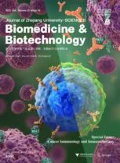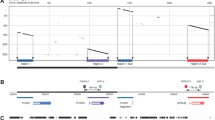Abstract
We cloned the complete coding sequences of porcine Gpr3, Gpr6, and Gpr12 genes. Further, on the basis of their high levels of sequence similarity, these genes are identified as a subfamily of G protein-coupled receptors. These putative protein sequences also showed high sequence identity with other mammalian orthologs, including several highly conserved motifs. A wide expression of the Gpr3 gene in pigs was observed through tissue distribution analysis by reverse transcriptase-polymerase chain reaction (RT-PCR) and real-time PCR, specially in the brain, pituitary, fat, liver and oocyte, where its strong expression was observed. The Gpr3 gene was found to be located on chromosome 6 and a single exon coded for the entire open-reading frame. Expression of porcine Gpr3 in HEK293 cells resulted in constitutive activation of adenylate cyclase (AC) similar in amplitude to that produced by fully stimulated Gs-coupled receptors. Moreover, sphingosine 1-phosphate (S1P) could increase AC activation via the constitutively active Gpr3 receptor. When a Gpr3-green fluorescent protein (GFP) construct was expressed in HEK293 cells, GFP-labeled Gpr3 protein was shown to be localized in the plasmalemma and subcellular membranes. After S1P treatment, agonist-mediated internalization could be visualized by confocal microscopy. In short, our findings suggest the porcine Gpr3, Gpr6, and Gpr12 genes as a subfamily of G protein-coupled receptors, and porcine Gpr3 was a constitutively active G protein-coupled receptor. Constitutive activation of AC and agonist-mediated internalization of Gpr3 receptor could be modulated by the S1P, suggesting that S1P might act as an activator for porcine Gpr3 receptor.
Similar content being viewed by others
References
Alewijnse, A.E., Timmerman, H., Jacobs, E.H., Smit, M.J., Roovers, E., Cotecchia, S., Leurs, R., 2000. The effect of mutations in the DRY motif on the constitutive activity and structural instability of the histamine H2 receptor. Mol. Pharmacol., 57(5):890–898.
Clemens, J.J., Davis, M.D., Lynch, K.R., Macdonald, T.L., 2003. Synthesis of para-alkyl aryl amide analogues of sphingosine-1-phosphate: discovery of potent S1P receptor agonists. Bioorg. Med. Chem. Lett., 13(20):3401–3404. [doi:10.1016/S0960-894X(03)00812-6]
Conway, B.R., Minor, L.K., Xu, J.Z., Gunnet, J.W., DeBiasio, R., D'Andrea, M.R., Rubin, R., Giuliano, K., DeBiasio, L., Demarest, K.T.,1999. Quantification of G-protein coupled receptor internatilization using G-protein coupled receptor-green fluorescent protein conjugates with the ArrayScantrade mark high-content screening system. J. Biomol. Screen., 4(2):75–86. [doi:10.1177/108705719900400207]
DiLuigi, A., Weitzman, V.N., Pace, M.C., Siano, L.J., Maier, D., Mehlmann, L.M., 2008. Meiotic arrest in human oocytes is maintained by a Gs signaling pathway. Biol. Reprod., 78(4):667–672. [doi:10.1095/biolreprod.107.066019]
Hinckley, M., Vaccari, S., Horner, K., Chen, R., Conti, M., 2005. The G-protein-coupled receptors GPR3 and GPR12 are involved in cAMP signaling and maintenance of meiotic arrest in rodent oocytes. Dev. Biol., 287(2): 249–261. [doi:10.1016/j.ydbio.2005.08.019]
Howard, A.D., McAllister, G., Feighner, S.D., Liu, Q., Nargund, R.P., van der Ploeg, L.H., Patchett, A.A., 2001. Orphan G-protein-coupled receptors and natural ligand discovery. Trends Pharmacol. Sci., 22(3):132–140. [doi:10.1016/S0165-6147(00)01636-9]
Ignatov, A., Lintzel, J., Hermans-Borgmeyer, I., Kreienkamp, H.J., Joost, P., Thomsen, S., Methner, A., Schaller, H.C., 2003a. Role of the G-protein-coupled receptor GPR12 as high-affinity receptor for sphingosylphosphorylcholine and its expression and function in brain development. J. Neurosci., 23(3):907–914.
Ignatov, A., Lintzel, J., Kreienkamp, H.J., Schaller, H.C., 2003b. Sphingosine-1-phosphate is a high-affinity ligand for the G protein-coupled receptor GPR6 from mouse and induces intracellular Ca2+ release by activating the sphingosine-kinase pathway. Biochem. Biophys. Res. Commun., 311(2):329–336. [doi:10.1016/j.bbrc.2003.10.006]
Iismaa, T.P., Kiefer, J., Liu, M.L., Baker, E., Sutherland, G.R., Shine, J., 1994. Isolation and chromosomal localization of a novel human G-protein-coupled receptor (GPR3) expressed predominantly in the central nervous system. Genomics, 24(2):391–394. [doi:10.1006/geno.1994.1635]
Joost, P., Methner, A., 2002. Phylogenetic analysis of 277 human G-protein-coupled receptors as a tool for the prediction of orphan receptor ligands. Genome Biol., 3(11): RESEARCH0063. [doi:10.1186/gb-2002-3-11-research0063]
Kabarowski, J.H., Zhu, K., Le, L.Q., Witte, O.N., Xu, Y., 2001. Lysophosphatidylcholine as a ligand for the immunoregulatory receptor G2A. Science, 293(5530):702–705. [doi:10.1126/science.1061781]
Ledent, C., Demeestere, I., Blum, D., Petermans, J., Hamalainen, T., Smits, G., Vassart, G., 2005. Premature ovarian aging in mice deficient for Gpr3. PNAS, 102(25):8922–8926. [doi:10.1073/pnas.0503840102]
Mehlmann, L.M., Saeki, Y., Tanaka, S., Brennan, T.J., Evsikov, A.V., Pendola, F.L., Knowles, B.B., Eppig, J.J., Jaffe, L.A., 2004. The Gs-linked receptor GPR3 maintains meiotic arrest in mammalian oocytes. Science, 306(5703): 1947–1950. [doi:10.1126/science.1103974]
Moller, S., Croning, M.D., Apweiler, R., 2001. Evaluation of methods for the prediction of membrane spanning regions. Bioinformatics, 17(7):646–653. [doi:10.1093/bioinformatics/17.7.646]
Murakami, A., Takasugi, H., Ohnuma, S., Koide, Y., Sakurai, A., Takeda, S., Hasegawa, T., Sasamori, J., Konno, T., Hayashi, K., et al., 2010. Sphingosine 1-phosphate (S1P) regulates vascular contraction via S1P3 receptor: investigation based on a new S1P3 receptor antagonist. Mol. Pharmacol., 77(4):704–713. [doi:10.1124/mol.109.061481]
Nakai, K., Horton, P., 1999. PSORT: a program for detecting sorting signals in proteins and predicting their subcellular localization. Trends Biochem. Sci., 24(1):34–36. [doi:10.1016/S0968-0004(98)01336-X]
Padmanabhan, S., Myers, A.G., Prasad, B.M., 2009. Constitutively active GPR6 is located in the intracellular compartments. FEBS Lett., 583(1):107–112. [doi:10.1016/j.febslet.2008.11.033]
Pyne, S., Pyne, N.J., 2000. Sphingosine 1-phosphate signalling in mammalian cells. Biochem. J., 349(Pt 2):385–402. [doi:10.1042/0264-6021:3490385]
Ruiz-Medina, J., Ledent, C., Valverde, O., 2011. GPR3 orphan receptor is involved in neuropathic pain after peripheral nerve injury and regulates morphine-induced antinociception. Neuropharmacology, 61(1–2):43–50. [doi:10.1016/j.neuropharm.2011.02.014]
Saeki, Y., Ueno, S., Mizuno, R., Nishimura, T., Fujimura, H., Nagai, Y., Yanagihara, T., 1993. Molecular cloning of a novel putative G protein-coupled receptor (GPCR21) which is expressed predominantly in mouse central nervous system. FEBS Lett., 336(2):317–322. [doi:10.1016/0014-5793(93)80828-I]
Tanaka, S., Ishii, K., Kasai, K., Yoon, S.O., Saeki, Y., 2007. Neural expression of G protein-coupled receptors GPR3, GPR6, and GPR12 up-regulates cyclic AMP levels and promotes neurite outgrowth. J. Biol. Chem., 282(14): 10506–10515. [doi:10.1074/jbc.M700911200]
Tanaka, S., Shaikh, I.M., Chiocca, E.A., Saeki, Y., 2009. The Gs-linked receptor GPR3 inhibits the proliferation of cerebellar granule cells during postnatal development. PLoS One, 4(6):e5922. [doi:10.1371/journal.pone.0005922]
Uhlenbrock, K., Gassenhuber, H., Kostenis, E., 2002. Sphingosine 1-phosphate is a ligand of the human gpr3, gpr6 and gpr12 family of constitutively active G protein-coupled receptors. Cell. Signal., 14(11):941–953. [doi:10.1016/S0898-6568(02)00041-4]
Valverde, O., Celerier, E., Baranyi, M., Vanderhaeghen, P., Maldonado, R., Sperlagh, B., Vassart, G., Ledent, C., 2009. GPR3 receptor, a novel actor in the emotional-like responses. PLoS One, 4(3):e4704. [doi:10.1371/journal.pone.0004704]
Whorton, M.R., Bokoch, M.P., Rasmussen, S.G., Huang, B., Zare, R.N., Kobilka, B. Sunahara, R.K., 2007. A monomeric G protein-coupled receptor isolated in a high-density lipoprotein particle efficiently activates its G protein. PNAS, 104(18):7682–7687. [doi:10.1073/pnas.0611448104]
Wittenberger, T., Hellebrand, S., Munck, A., Kreienkamp, H.J., Schaller, H.C., Hampe, W., 2002. GPR99, a new G protein-coupled receptor with homology to a new subgroup of nucleotide receptors. BMC Genomics, 3(1):17. [doi:10.1186/1471-2164-3-17]
Xiao, M.F., Xu, J.C., Tereshchenko, Y., Novak, D., Schachner, M., Kleene, R., 2009. Neural cell adhesion molecule modulates dopaminergic signaling and behavior by regulating dopamine D2 receptor internalization. J. Neurosci., 29(47):14752–14763. [doi:10.1523/JNEUROSCI.4860-09.2009]
Xu, Y., Zhu, K., Hong, G., Wu, W., Baudhuin, L.M., Xiao, Y., Damron, D.S., 2000. Sphingosylphosphorylcholine is a ligand for ovarian cancer G-protein-coupled receptor 1. Nat. Cell Biol., 2(5):261–267. [doi:10.1038/35010529]
Zhang, B., Ding, J., Li, Y., Wang, J., Zhao, Y., Wang, W., Shi, S., Dong, F., Zhang, Z., Shi, F., et al., 2012. The porcine Gpr3 gene: molecular cloning, characterization and expression level in tissues and cumulus-oocyte complexes during in vitro maturation. Mol. Biol. Rep., 39(5):5831–5839. [doi:10.1007/s11033-011-1393-y]
Author information
Authors and Affiliations
Corresponding author
Additional information
Project supported by the National High-Tech R&D Program (863) of China (No. 2006AA10Z136) and a Grant-in-Aid for Innovative Training of Doctoral Students in Jiangsu Province of China (No. CXLX11-0701)
Rights and permissions
About this article
Cite this article
Zhang, Bl., Li, Y., Ding, Jh. et al. Sphingosine 1-phosphate acts as an activator for the porcine Gpr3 of constitutively active G protein-coupled receptors. J. Zhejiang Univ. Sci. B 13, 555–566 (2012). https://doi.org/10.1631/jzus.B1100353
Received:
Accepted:
Published:
Issue Date:
DOI: https://doi.org/10.1631/jzus.B1100353
Key words
- G protein-coupled receptor
- Constitutive activity
- Sphingosine 1-phosphate
- Receptor internalization
- Porcine Gpr3
- Molecular cloning




